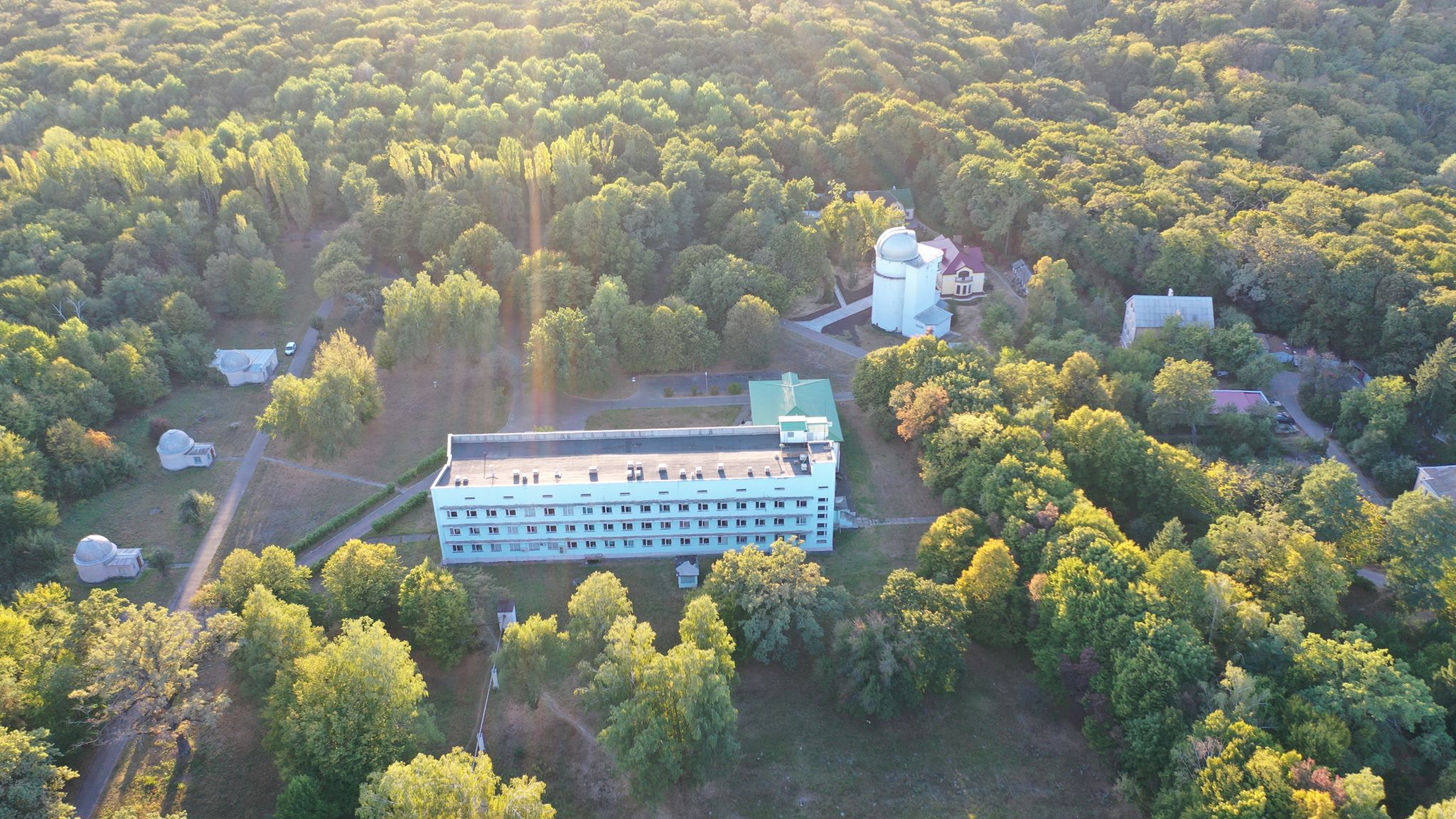The Department for Solar Physics
GENERAL INFORMATION
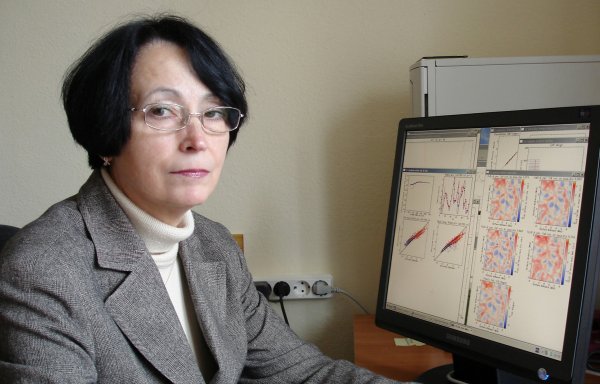 |
| The head of the Department Dr.Sci., the Correspond member of the NASU Shchukina N.G. |
Kiev was in the band of the total Solar eclipse on June 30 1954. Before this event some instruments were built for the eclipse observations in the Observatory. Three-camera astrograph and diffractional spectrograph were used for further regular Solar observations after solar eclipse. This was the beginning of the regular Solar researches in the Observatory..
The Solar Physics Department as the structural part of the Observatory was approved by the Academy of Sciences of Ukrainian SSR Presidium in 1964. The first head of the Department was Dr.Sci., Prof. Gurtovenko E.A. (1928-1994). Dr.Sci., the Correspond member of NASU Kostyk R.I. leaded the Department since 1983. Since 2003 the head of the Department is Dr.Sci, the Correspond member of the NASU Shchukina N.G.
THE DEPARTMENT STAFF
| Shchukina Nataliya | the Head of the Department | Dr.Sci., the Correspond member of NASU | shchukin(at)mao.kiev.ua | room 229 |
| Kostik Roman | major researcher | Dr.Sci., the Correspond member of NASU | kostik(at)mao.kiev.ua | room 320 |
| Osipov Sergei | senior researcher | PhD | osipov(at)mao.kiev.ua | ATsU-5 |
| Vasiljeva Irina | senior researcher | PhD | vasil(at)mao.kiev.ua | room 302a |
| Kondrashova Nina | researcher | PhD | kondr(at)mao.kiev.ua | room 303 |
| Chornogor Svetlanaна | researcher | PhD | chornog(at)mao.kiev.ua | room 303 |
| Sukhorukov Andriy | researcher | PhD. | suh(at)mao.kiev.ua | room 302 |
| Pasechnik Margarita | researcher | PhD | rita(at)mao.kiev.ua | room 303 |
MAIN RESEARCH AREAS
- Stokes diagnostics of Solar granulation and active phenomena (sunspots, flares, prominences, etc.);
- Spectropolarimetry of the quiet Sun;
- Solar magnetic fields;
- Modelling of the polarized radiation transfer in the Solar and stellar atmospheres;
- Wave processes modelling in the Solar atmosphere;
- the Solar global convection and differential rotation modelling;
- Helioseismology;
- Monitoring of long term variations of Fraunghofer lines parameters;
- Chemical abundances of the Sun, solar-type stars and stars, formed at early stages of the Universe evolution.
OBSERVATIONAL FACILITIES
The Department staff members carry out observations at telescopes with high level of automatization:
- ATsU-5 with a double-pass monochromator (Kyiv);
- ATsU-26 with a 5-camera spectrograph (Terskol, Elbrus, North Caucasus, IC AMER).
As well the Department researches participate in the joint observational programmes on the German Vacuum Telescope (VTT), Holland Open Telescope (DOT), French-Italic solar telescope (THEMIS), located on Canarian Islands (Spain).
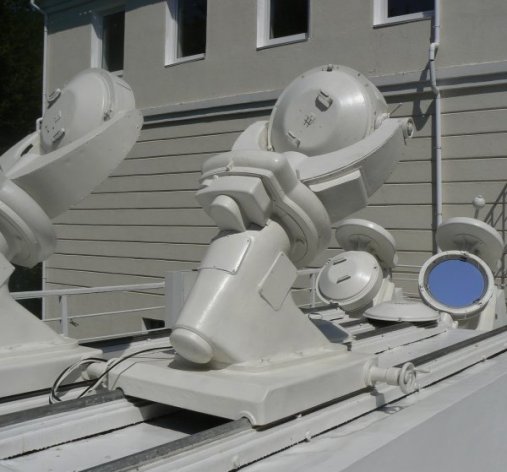 |
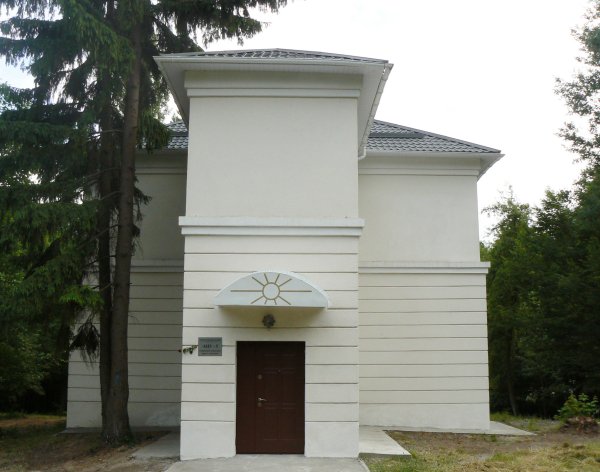 |
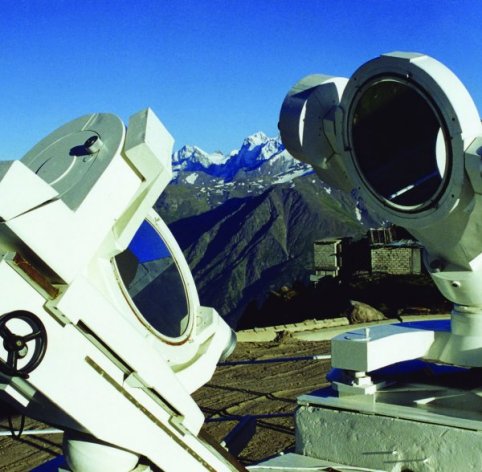 |
| ATsU-5 | ATsU-5 observing hut | ATsU-26 |
SCIENTIFIC COLLABORATION
The Department for Solar Physics has scientific collaboration with:
- Instituto de Astrofísica de Canarias (Tenerife, Spain);
- Center for mathematical Plasma Astrophysics (Leuven, Belgium).
- Institute of Solar-Terrestrial Physics, Siberian Branch of the RAN (Irkutsk, Russia)
- Pushkov Institute of Terrestrial Magnetism, Ionosphere and Radio Wave Propagation of the RAN (Troitsk, Russia)
- Kyiv and Lviv Universities
MAIN SCIENTIFIC ACHIEVEMENTS
- The horizontal solar telescope ATsU-5 with a double diffraction monochromator was modernized and put into operation. Due to its spectral resolution this is one of the most powerful telescopes in the world.
- Space observations of solar oscillations were carried out using orbital stations CORONAS-I and CORONAS-F.
- According to the VIRGO/SPM, GOLF (SOHO) and DYFOS (CORONAS-F) experiments abnormal brightness fluctuations and low-level p-mode velocities were detected; fluctuations of gravitational modes were not found. For the first time it was shown that waves, obtained from helioseismological analysis, are accelerated while passing under sunspots.
- Semi-empirical models of flares and active phenomena were built. They describe the temporal evolution of velocities field, magnetic field and temperature. A multidimensional magneto-hydrodynamic and magneto-hydrostatic models of photosphere and sunspots were developed as well.
- The search of effective source of the chromosphere and corona heating is one of the most essential problems of modern Solar physics. We show, that turbulent magnetic fields energy in the quiet Solar atmosphere can be substantially greater than predicted before. The amount of this energy is enough to heat the chromosphere and corona.
- An effective mechanism to explain the chromosphere heating is proposed. It is shown that currents dissipation, which is enhanced by the ambipolar diffusion, increases the temperature of the chromosphere on several thousand degrees per minutes.
- It is shown, that the process of wave propagation in the active region significantly deviates from the adiabatic. This decrease the limit frequency, so a 5-minute oscillations penetrate into the chromosphere and heat it additionally.
- It is shown that convection does not stop in the middle photosphere, as was considered previously, but extends to the lower chromosphere. In the middle photosphere convection elements change only the sign of relative contrast and the direction of the motion. Magnetic fields (400-1800 G) does not suppress convection, as predicted by theoretical calculations.
- Radiation distribution in the solar spectrum was obtained in absolute energy units for the 300-1060 nm wavelength range.
- Methods of local helioseismology of the Sun have been used to explain the rapid pulsations of Ap-magnetic peculiar stars. Magnetohydrodynamic simulations of these pulsations gave an opportunity to explain main observational properties of RoAp-stars.
- The problem of iron and silicon abundances in the solar photosphere was solved. Element ratios for large grid of stellar model atmospheres were obtained, which make it possible to estimate abundances of lithium, oxygen and iron, depending on stellar parameters.These results are important for solving of such fundamental issues of astrophysics as nucleosynthesis of chemical elements during the Big Bang, evolution of galaxies and stars, the internal structure and atmospheres structure of the Sun and stars.



 COORDINATES
COORDINATES